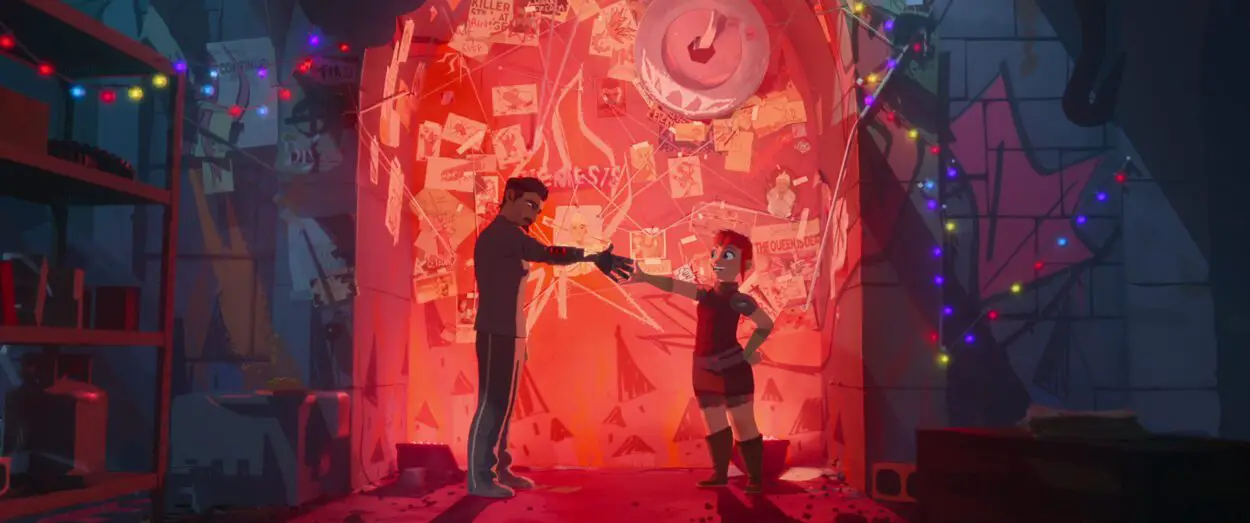In 2022 Netflix distributed one of the year’s biggest surprises with The Sea Beast, an animated family fantasy adventure with a positive message about challenging the narratives society teaches you that more than made up for its undeniably predictable story by just being so damn cool, with great voice-work, fun world-building, larger than life characters, great chemistry between its odd-couple leads, and fantastic action set pieces. Now a year later they’ve done almost exactly the same thing again with Nimona, based on a 2015 graphic novel by ND Stevenson, showrunner for She-Ra and the Princesses of Power and apparent current figurehead of Queer-themed family fantasy.
Disney reportedly passed on adapting Nimona previously due to those themes being too strong, and although Netflix have quite the poor track record as far as standing by their trans employees, they have at the very least, seemingly allowed Nimona onscreen with much of her zany queerness intact. Thank goodness, cause Nimona is one of the most fun characters of the year and I won’t pretend her capital as a gender-fluid icon isn’t a big part of that. She’s a they/them causing may/hem in the truest sense, and hilarious at that.
Though she’s the title character, Nimona (Chloe Grace Moretz) isn’t the protagonist of this film, though; that’s Ballister (Riz Ahmed) a commoner who will be the first to break the noble-blooded glass ceiling of the Institute, a band of knights devoted to defending the walled-off realm from monsters. However, someone clearly doesn’t like the idea of a brown-skinned gay commoner becoming a knight and so Ballister is framed, reviled, and thereafter sought out by Nimona, a feisty aspiring villain who wants to team up and take on society, while all Ballister wants to do is clear his name. But Nimona has more surprises in store, as neither she nor the Institute are who they first seem.
You can probably write the rest from there. Unpredictability is not one of this movie’s strengths, at least not on the macro-story level. You can pretty much see where it’s going the whole time. However, that needn’t be a fatal flaw and it isn’t when the characters are this likable, funny and well performed and the world this intriguing. The walled kingdom Ballister and Nimona inhabit is a familiar trope throughout fantasy, but Nimona puts its own twists on the formula: it’s medieval times, but all future-y and stuff. It’s a fun take on a fantasy setting that gives the animation department free reign to come up with some sleek designs.

But as fun as the world is and as much as it’s Ballister’s story, it’s very much Nimona’s show. There’s no mystery as to why she’s the title character. She’s a fantastic creation; not an original one, but a beautifully realized one. Grace Mortez does a fantastic job voicing her—Ahmed’s of course excellent too—balancing her weirdo eccentricity, humor and hyperactivity with the underlying loneliness and pain motivating her phenomenally well. I love her spunky design and the energy she brings to the screen, I could watch her break sh*t all day. And, I know I’m using her because that’s how she refers to herself in the film, but she’s clearly a cipher for Stevenson’s own non-binary, transmasculine identity. This isn’t like SpiderVerse where they color-co-ordinate her outfit and boom! Trans representation! (for the record, I know Gwen Stacy’s transness runs deeper than that and I did really love what that movie did with her character, the art style especially). No, this is an accurate representation of what it feels like to grow up as genderfluid: not fitting in anywhere, feeling like you’re doing something wrong when you’re just being yourself, but also feeling powerful because you can be anything: strong, demure, pretty, handsome, sharp, soft…anything. Until you find others who understand you, but by then you’ve learned to become so self-reliant and jaded that it’s hard to feel loved that way. Nimona is one of the best pieces of non-binary representation that I have ever seen and I cannot applaud her characterization or what the film uses her to say enough. Thematically she’s less comparable to Across the SpiderVerse’s Gwen Stacy and more akin to its Hobie, an impact character who imparts the all important lesson to the protagonist: sometimes, sh*t just needs to get broken.
There may be issues with Nimona—it’s not the most radical reinvention of the tropes it’s utilizing—but I really did not care while watching. I was just having too much fun. It’s a sleek, fun, funny, larger than life fantasy adventure that I am praying finds its audience and becomes the future classic it deserves to be. Disney have made a tonne of mistakes these last few years but passing on this is honestly unforgivable. Shame on them! Nimona rules!




